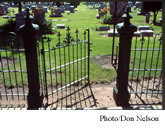
Stories are legion of people trying to sprinkle their loved ones’ ashes on the football field, in the woods around the lakes, and elsewhere on campus. Such actions violate Catholic doctrine, which requires treating cremated remains with the same reverence as a full body. Ashes are supposed to be buried or inurned in a niche.
It hasn’t been possible for alumni to be properly laid to rest at Notre Dame because the Holy Cross Community Cemetery, above Saint Mary’s Lake, takes only CSC priests and religious brothers. And graves in Cedar Grove, the shady cemetery on Notre Dame Avenue south of the Morris Inn, have been available for purchase only by current and retired Notre Dame faculty and staff.
Now the University is considering opening up Cedar Grove to alumni. An open-air garden mausoleum at the west end would feature vaults for bodies and niches for cremated remains. And a Columbarium Walk, running from the cemetery’s All Soul’s Chapel westward, would be flanked by benches and sections of a low wall with niches for cremated remains.
The vaults and niches would be available for sale to alumni. In-ground burial in Cedar Grove will continue to be limited to purchase by faculty and staff.
Another proposed change would create a memorial walkway running from Notre Dame Avenue back to the entrance of the chapel. This path would be paved with bricks that alumni could purchase and have engraved with the name of an alumnus buried somewhere else. In this way the person could be memorialized at Notre Dame.
These plans are not definite, and no prices have been set. Administrators are in the process of surveying alumni to gauge interest. But if strong enough demand is found to exist, the first stage could commence as early as this fall.
The project has been dubbed “Coming Home” because fewer people than in the past remain in the city where they were born and raised, but many Notre Dame alumni reunite on campus with family and friends for weddings, baptisms, reunions and, of course, football games.
“It is the one place some have in common after the family home,” writes Alumni Chaplain Father Bill Seetch, CSC, ‘74, ’78M.Div. in the letter accompanying the alumni survey. “That it would be the desired spot to be laid to rest is no surprise. For many of us this side of heaven, Notre Dame is home.”
The University’s interest in redeveloping Cedar Grove was driven not only by alumni interest in being laid to rest there and growing interest in cremation but because Cedar Grove is running out of room. At the present rate of grave purchases, the cemetery is expected to be full in 65 years.
In addition to the new above-ground memorials, longer-term plans call for removing some access roads through the grounds and moving maintenance facilities to the southwest corner. Those changes would create space for additional faculty and staff burials. More than 10,000 people are already buried in Cedar Grove.
Taken together, the open-air mausoleum, Columbarium Walk and a noncontiguous niche “fence” envisioned at some future date for along the northern border would have a total capacity of 1,750 vaults and 3,200 niches.
Cedar Grove Cemetery was laid out in 1838, four years before the University’s founding, by Father Benjamin Petit, the third Catholic priest dispatched to preach to the Potawatomie Indians on the northern Indiana frontier. He died the following year, at age 27, while on his way back from accompanying the Indians on the notorious Trail of Death, their forced removal to a reservation in Kansas. Petit’s remains lie not in Cedar Grove but beneath the Log Chapel.
For more information on Coming Home, visit the website http://cominghome.nd.edu, contact project director Allison Heuring at 574-631 5660, or email cominghome@nd.edu.